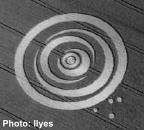|
The physical changes (listed below) documented
in crop circle plants by Michigan biophysicist W.C. Levengood have
been determined by evaluating hundreds of sample plants -- both
downed and standing -- taken from inside the overall perimeter
of each formation against hundreds of control plants taken at varying
distances outside each formation, in several directions. More than
250 individual crop formations from multiple countries, over a 10-year
period were examined in-depth. Although many of the formations studied
were relatively "simple" in overall design and/or relatively "small"
in overall size (primarily because of BLT's financial and/or personnel
limitations, particularly in Europe), many larger and more "complex"
formations -- those whose overall design included intricate geometric
shapes with multiple design elements of varying sizes -- are represented
here.
Many of the formations occurred in European countries and, in those
cases, the plants were dried-down in open air for 4-6 weeks prior
to shipping to the U.S. Some of the U.S. and Canadian formations
were shipped while still green. The physical changes found in these
crop circle plants, outlined below, have all been determined to
be statistically significant at the 95% level of confidence:
1. |
On the microscopic
level, abnormal enlargement of cell wall pits in bract tissue
(a thin membrane which surrounds the seed- head and through
which nutrients pass to the developing seed) were found.
This examination utilizes the optical microscope and is quite
time-consuming and, although useful in the early, exploratory
stages of the research, was replaced when equally reliable criteria
were subsequently discovered.
|
2a. |
Enlarged
(both laterally and longitudinally) plant stem nodes
- the fibrous "knucle-like" protuberances found spaced along
the plant stem beneath the seed-head, technically called "pulvini."
Although these nodes are sometimes enlarged both laterally
(they are "fatter") and longitudinally (they are "stretched"),
extensive laboratory work has determined that it is the node
elongation (the stretching) that is a permanent
effect caused by the formation energies - and so this is the
parameter now used.
|
2b. |
In some crop formations
the energy system involved is intense enough to cause bending
of this apical (top) node (although pronounced node bending
is much more commonly found at the lower nodes on the plant
stem). In a few cases we have found severe apical node bending
in conjunction with marked stretching
of the node. As the example, below, illustrates the node elongation
in such cases is clearly in addition
to that caused by the bending of the node tissues.
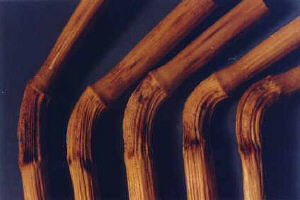 |
| Sample
plants with apical node elongation and
extreme bending, in wheat from a Maryland, USA crop
formation. |
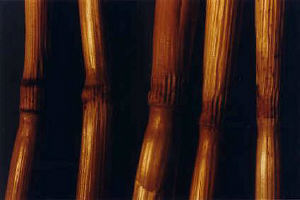 |
| Apical
nodes in control plants from the same field, taken a
distance away from the crop formation. |
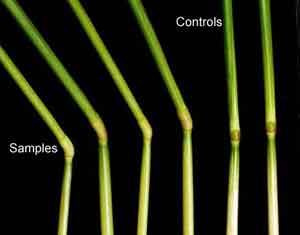 |
| Four plants
on left (from an Italian crop circle) show apical node
elongation & slight bending. Two apical nodes on right
are from controls. |
|
3a. |
Marked bending
of the plant stem nodes which can occur at all of
the nodes in some cases, is most often observed in the 2nd,
3rd and 4th nodes down toward the bottom of the stalks. It
does occasionally occur in the first, or apical node beneath
the seed-head (see above). Usually this bending (if it is
determined to be significant after ruling out natural plant
recovery processes) is in the range of 45-90 degrees and considerable
care must be taken to not confuse this node bending with two
well-known plant recovery processes:
(1) phototropism
(the plant's natural tendency to reorient itself to sunlight)
and;
(2) gravitropism
(the plant's natural tendency to reorient itself to the earth's
gravitational field).
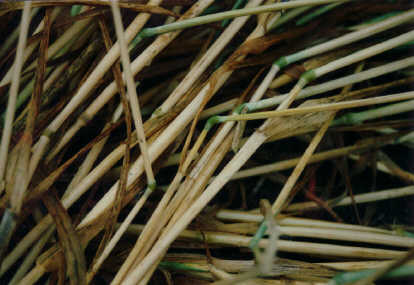 |
| NODE
BENDING, which may (depending on the age of the crop
when formation occurred & time elapsed since then) or
may not be indicative of the genuine phenomenon.
|
Depending upon the growth-stage of the plant at the time it
is downed (whether it is young or old) and the species of crop
involved, these natural recovery processes - phototropism and
gravitropism - begin to take effect within days. Therefore node
bending can only be understood as significant when it is known
how old the affected crop was at the time the crop circle occurred
and, particularly, how many days have elapsed since then. [Young
barley, for instance, begins recovery to the up-right position
almost immediately and will show significant node bending within
a week; young wheat tends to recover slightly more slowly. And
mature crop may not reorient itself at all, depending on the
amount of vigor inherent in the plants.] But when crop circles
are known to have formed during a specific time period and are
found within 24-48 hrs., and significant node bending (40°
+) is observed, this is an effect that can be attributed to
the causative energy system. In some cases canola (rape-seed)
plants have been observed to be bent at a full 180°.
|
3b. |
Bending at the base
of the plant stem is a totally separate condition
which is thought by many people to indicate that any formation
in which it is found is "genuine" (not mechanically
flattened). This type of bending is found at the very bottom
of the stem, where it comes out of the earth, and is often
quite pronounced.
|
|
Marked
bending at the base of conola/oilseed
rape plants -- which are known to break, not bend, when
mechanically flattened.
Photos: Janet Ossebaard |
Although this particular parameter
has not been scientifically evaluated,
it is known that mechanical flattening (with planks, boards
or human feet) of many plants (particularly canola, above)
will snap or break the plant stems, rather than bend them.
As the summer progresses and the cereal crops - in which a
majority of the crop formations occur - dry down, the plants
become less and less elastic, making bending at the stem base
in these crops perhaps more significant later on in the season.
|
4. |
Expulsion cavities
(holes blown out at one or several of the plant
stem nodes) are most often found in the 2nd node beneath the seed-
head. However, in recent years they are being seen also in the 3rd
and 4th nodes down the plant stem, as well as occasionally occurring
in the top (apical) node. These holes are thought to be one of the
plant abnormalities caused by exposure to microwave radiation which -- particularly in circles which occur in young, green crop -- instantly
turns the plant's internal moisture to steam. If the microwaves are
intense enough -- and the amount of moisture at the stem node great
enough -- the rapidly expanding steam in these lower nodes can only
escape by blowing holes out through the tough external fibers in
these lower nodes. [In the apical, or top, nodes -- the youngest part
of the plant -- the external fibers are considerably more elastic and
the steam created there by exposure to microwaves seeps out more
easily, stretching the nodes at the tops of the plants as it does so.]
A darkening of the stem node around expulsion cavities is sometimes
also seen, and this is usually the result of the growth of an
opportunistic fungus (Ustilago tritici) which quickly forms on the
exudate released from inside the plant stem.
(See: http://www.bltresearch.com/labreports/mission1.php.)
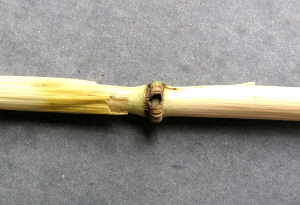 |
Expulsion cavity typical of those often found in crop circle
samples, but very rarely seen in control plants examined
by W.C. Levengood. However, the data indicates this
abnormality is not present in all "genuine" formations. |
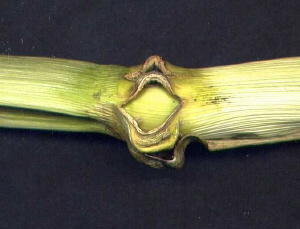 |
Expulsion cavity in corn (maize). Thought to result from
intense, very brief bursts of microwaves which
instantly turn the moisture inside the
plant stem nodes to steam. |
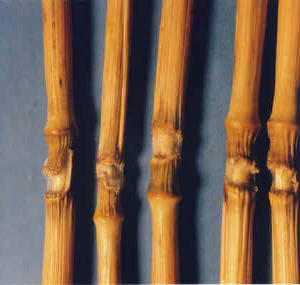 |
| Expulsion
cavities in older, mature plants can also look like
this example, in mature wheat. |
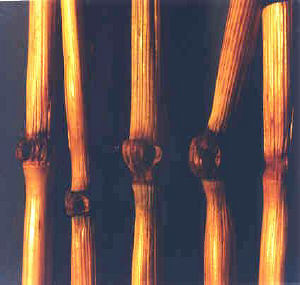 |
| Expulsion
cavities in older, mature barley plants. |
|
5. |
Stunted, malformed seeds and
germination effects. There are four basic changes to the
seeds and germination capability in crop circle plants documented
so far. These radically different reproductive effects depend
upon the species of crop involved, the growth phase of the plants
at the time the crop circle occurs, and the composition and
intensity level of the energy system involved (which appears
to differ slightly within each event as well as from event to
event):
|
|
(a)
If the crop circle occurs prior to anthesis (the flowering
of the plant) and the development of the seed, the somatic
(non-reproductive) tissue of the plant will continue to develop
normally -- but seed development ceases or is impaired. Normally-formed
glumes have been found which are totally devoid of seeds.
 |
SEED-HEADS,
WHEAT
Crop circle seed-head (right) has no seeds, due to destruction
of plant's reproductive capacity. Found only when crop
circles occur in very immature plants. |
|
|
(b)
When crop circles occur at a slightly later growth stage,
in young crop where the seed is still forming, the developing
embryo fails to grow normally. These seeds will be visually
stunted (smaller), will weigh less than their controls, and
will exhibit reduced or repressed germination. Here,
the reproductive capacity of the plant has been compromised.
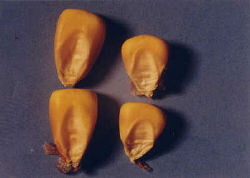 |
STUNTED & DEHYDRATED
MAIZE SEEDS (on right).
These occur when embryos are already formed, or partially
formed,
when crop circle occurs. |
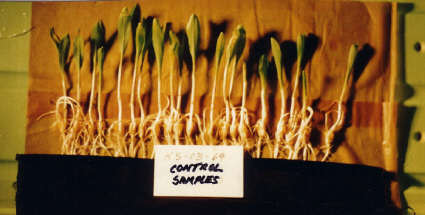 |
|
CONTROL MAIZE SEEDLINGS AT 7 DAYS |
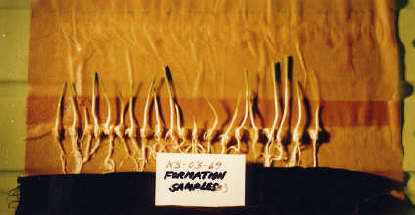 |
FORMATION MAIZE SEEDLINGS AT 7 DAYS
Showing reduced seedling growth-rate, which typically
occurs if crop circles form in plants which are at an
intermediate growth-stage. |
|
|
(c) When crop circles
occur in more mature plants, where the embryo is fully formed
or nearly so, the seeds will again be visually stunted and will
weigh less than normal, but the effects on reproduction vary.
One effect observed has been an alteration in normal growth-habit
of the developing seedlings: in species which have a normal
variability of growth at particular stages, this variability
has been lost -- with the result being that all of the germinating
seeds exhibit synchronized growth.
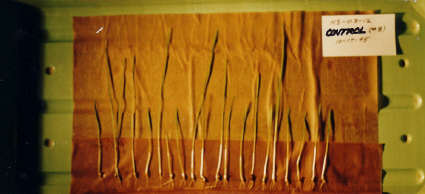 |
CONTROL
SEEDLINGS, 12-DAY WHEAT
Showing normal variation of growth-rate (height)
for this particular species at this stage of development.
|
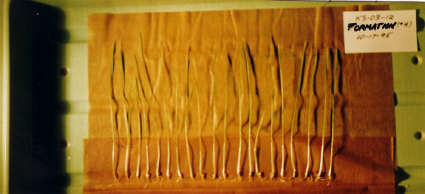 |
FORMATION
SEEDLINGS, 12-DAY WHEAT
Showing induced synchronization of growth.
|
|
(d) |
(d)
Finally, when crop circles occur in mature plants with fully
formed seeds, these seeds often exhibit a statistically
significant massive increase in growth rate and vigor,
with growth-rate up to five times the rate of the control
seeds. Further, these seedlings can tolerate extreme stress
(lack of water and/or light) for considerable periods of time
without apparent harm.
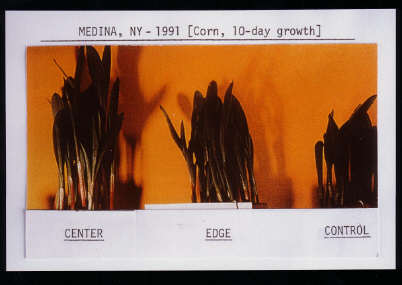 |
INCREASED GROWTH-RATE OF FORMATION SEEDLINGS
(as opposed to controls), in seeds from crop which
was mature when crop circle formed. |
The plant aberrations described
above are thought to be caused by exposure of the plants to
a complex atmospheric plasma energy system which is emitting
heat (probably microwaves) in association with unusual electrical
pulses and strong magnetic fields. The microwave component
heats up the internal moisture in the plant stems (even mature
crop nearing harvest contains some moisture), turning it to
steam. In younger crop, where the external fibers are more
elastic, the steam seeps out at the nodes by stretching these
fibers; in older crop, where the external fibers are tougher
and less elastic, the build-up of steam explodes out from
the nodes, creating the holes subsequently found. The final
effects on the individual plants depend upon a number factors,
including the complexity and intensity level of the microwave
component (which varies in each event and from location to
location within any given crop circle), the modifying influence
of the electrical pulses also involved, as well as the species,
variety and age of the plants involved.
|
6. |
Beer-Lambert
Principle. A clear indicator of the electromagnetic
nature of the energies which cause node-length change in crop
circles is the discovery that, in some formations, node-length
change decreases from the center of the circle out to its edges
in a very precise manner. In fact, these node-length
changes were found to agree with a well-known law in physics
-- the Beer-Lambert Principle -- which describes
the absorption of EM energy by matter. In these cases the node-length
increase was greatest at the center of the circle, decreasing
as a function of sampling distance away from the center and
toward the perimeter.
Example 1, below, is of a completely flattened circle;
examples 2 & 3 each had a standing central tuft.
[Example 1]
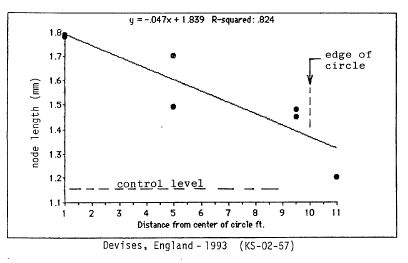
[Example 2]
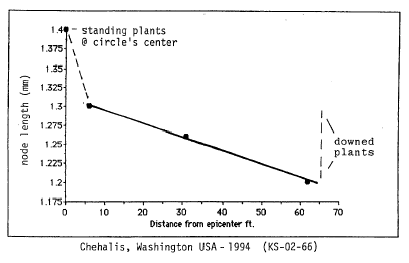
[Example 3]
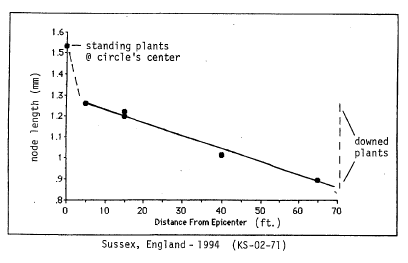
In another case, involving a simple circle in southern Holland,
a bright "pinkish-purple" football-shaped light was seen to
hover low over a field. It then elongagated into a disc-shaped
light, subsequently discharging an energy (described by the
witness as "like the Shuttle") down toward the crop
surface, at which time the plants flattened into a circle. This
circle was carefully sampled along three diameters and, in the
laboratory, it was found that the node-length changes on both
sides of each sampled diameter precisely mirrored each other
-- but each diameter's node-length changes differed
from those found along the other two diameters. Exactly
how this effect could have been produced is not understood.
|
7. |
Laboratory
Replication of Crop Circle Plant Changes. Apical node
(the first node beneath the seed-head) elongation and expulsion
cavities (holes blown out at the lower plant-stem nodes) have
been induced in normal plants in the laboratory by placing them
in a commercial microwave oven for between 20-30 seconds. It
is microwave radiation, here, that is heating up the moisture
inside the plant stem which--as it turns to steam and expands--either
stretches the more elastic fibers at the top of the plant, or
blows holes in the tougher nodes farther down the plant stem.
The more positive plant changes--enhanced growth rate, increased
yield & increased stress tolerance--observed in the laboratory
in seedlings grown from cropcircle plants which were mature
when the crop circles occured, have also been
replicated in the laboratory. In 1998 W.C. Levengood
and John Burke obtained a patent (Patent #5740627) on equipment
they developed which delivers unusual electrical pulses to
normal seed. Called the MIR process and carrying the
registered Trademark "Stressguard," this
equipment creates organized electron-ion avalanches which
then form organized plasmas, to which seeds are exposed.
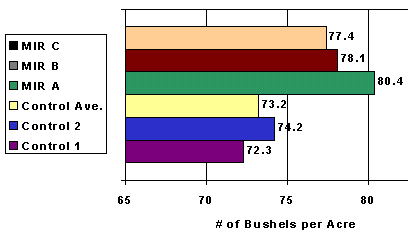 |
Graph showing increased yield consistently produced
by seed treated with MIR "Stressguard" process. |
Corn, tomato, carrot and many other
seeds will, after exposure to the MIR
"Stressguard" process, show increased seedling
growth-rate and accelerated maturity, increased yield (25-35%),
and a substantial improvement in ability to withstand typical
plant "stressors" (lack of water and/or sunlight).
Numerous field trials conducted by multiple universities and international seed companies substantiated these results and John Burke spent several years attempting to find a commercial application. Since John's death the web-site he created describing in detail the MIR "Stressguard" process and its results is no longer active, but it is archived here: http://www.proseedtech.com.
The ability to replicate in the laboratory many of the changes
documented in cropcircle plants is a strong indicator that
the energies utilized in the lab are also involved as causative
mechanisms in the field. In the field the major question is
where are these plasma systems originating, and why?
|
8. |
Non-Geometrically
downed crop. An important final note regarding these
changes to crop circle plants is the fact that non-geometrically-downed
crop -- usually called "lodging" by farmers and attributed
to over-fertilization of the field and/or subsequent weather
damage -- has sometimes been found to show these same
changes (see Non-Geometric
Crop Formations). This more randomly-downed, or
chaotically-downed crop is often observed in the same fields
in which "geometric" crop circles occur, but is also found
in fields where no geometric crop circle exists. In some cases
it is thought that this chaotically-downed crop is due to
weather damage alone. However, testing has revealed that in
many instances the same energetic situation involved in the
geometric events is also involved in these non-geometrically
downed areas. A control study carried out in 1997 did not
reveal any of the typical plant anomalies in 100% over-fertilized
wheat grown for commercial harvest. |
[Laboratory Photos &
Graphs: W.C. Levengood]
|

